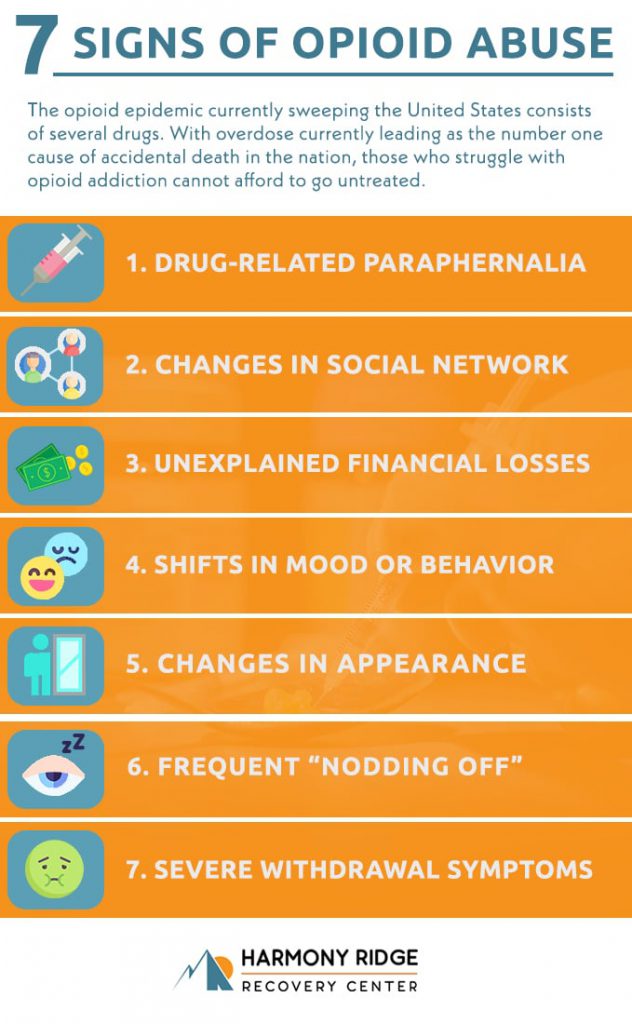The opioid epidemic currently sweeping the United States consists of several drugs. With overdose currently leading as the number one cause of accidental death in the nation, those who struggle with opioid addiction cannot afford to go untreated.
Before you confront your loved one about their possible opioid addiction, you should look out for the following common signs of opioid abuse.
Signs Of Opioid Abuse
- Drug-Related Paraphernalia
- Changes in Social Network
- Unexplained Financial Losses
- Drastic Shift in Mood or Behavior
- Changes in Appearance
- Frequent “Nodding Off”
- Severe Withdrawal Symptoms
1. Drug-Related Paraphernalia
The type of paraphernalia used to smoke or inject heroin may initially seem harmless. For instance, smokers may use aluminum foil, with a straw to inhale the smoke. These household objects have several purposes outside of drug use.

Some heroin smokers use pipes, which make for slightly easier identification. Meanwhile, those who inject may require paraphernalia such as shoelaces (to tie off), spoons, bottle caps, and cotton balls. Again, these items generally seem harmless. However, a burnt spoon and a shoelace — especially in proximity to a needle — should leave little room open for doubt.
It’s important to understand the most common forms of opioids to be able to recognize such paraphernalia to look out for. Common forms of opioids include:
- Heroin
- Fentanyl
- Codeine
- Morphine
- Oxycodone (OxyContin, Percocet)
- Hydrocodone (Vicodin)
- Oxymorphone (Opana)
- Hydromorphone (Dilaudid)
Some may use similar tools if they choose to administer opioid pills intravenously for the sake of immediate effect. However, in the case of prescription drug abuse, your primary indicator will be the pills themselves. Many opioid users tend to acquire their drugs through “doctor shopping,” meaning they might possess several bottles of the same medication with different doctors’ names on them. Even the patient name may differ if the user acquires their drugs from a dealer or other illegitimate source.
If your loved one seems to hoard pill bottles, or if pill bottles begin piling up in the trash, you might reasonably suspect opioid addiction as the cause.
2. Change in Social Network

Generally speaking, drug abuse of any kind tends to result in a shift of priorities. As drugs take a more prominent role in the user’s life, they spend less time around people who don’t use. Fellow users take the place of their old friends. When asked what they do with these new friends, your loved one may become secretive or even defensive.
You may also notice your loved one becoming isolated and withdrawn, spending most of their time alone when not with their new social circle. Again, they might get very shifty about discussing what they do with this alone time.
This particular warning sign does not always hint at opioid use. Especially in younger individuals, a change of social circles can be quite natural. Those who appear to isolate may also just be in the midst of a very natural phase. However, do not simply use this fact to write off these behaviors. If they appear in conjunction with other possible warning signs of opioid use, you should continue to pay attention.
3. Unexplained Financial Losses
Drugs cost money. Heroin tends to sell at a much cheaper rate than prescription opioids, but the price of chronic use still adds up. In the case of prescription drugs, a heavy user’s habit may even cost more than their typical living expenses. On top of this, many heavy users struggle to gain or keep employment. As a result, many heroin or opioid addicts find themselves living on a shoestring budget. Some even turn to begging or theft to finance their addiction.
You can consider this another possible warning sign that doesn’t necessarily indicate opioid use. Nonetheless, if your loved one suddenly begins struggling with finances, you may want to inquire about the cause. If they cannot explain their sudden budgetary issues, or if they try to avoid the question, you can sensibly assume that they’re hiding something. That “something” may very well be an expensive drug habit.
4. Drastic Shift in Mood or Behavior
Under the influence of opioids, your loved one will not act like themselves. They may appear significantly more euphoric than usual. This elation may also be marked with moments of confusion and incoherent or inconsistent thoughts. If the user is in the process of coming down, their mood may begin shifting dramatically from one extreme to the next. Previously joyous to the point of provoking suspicion, they suddenly become irritable or withdrawn. Due to the effects of opioids on the brain’s dopamine receptors, they may even seem outright depressed when the drugs wear off.
These types of mood shifts are also associated with mental health issues such as manic depression or bipolar disorder. Even if you do not suspect opioid abuse, you should pay attention to them. In some cases, sufferers of these and other mental disorders will turn to drugs as a form of self-medication. By paying attention to these warning signs, you may accomplish more than simply identifying a possible case of opioid addiction. You may prevent such a case from developing in the first place.
5. Changes in Appearance

Heroin and other opioids often suppress the user’s appetite. Sudden weight loss may therefore indicate the use of opioids or other drugs. In some cases, the user loses so much weight as to result in malnutrition. Those who use indoors may also spend great lengths of time in isolation, leading to a notable skin pallor. In addition to receiving little in the way of sun or nourishment, heavy users may also start to neglect their hygiene.
It should be noted that these signs are generally considered to be incredibly stereotypical. You will not always see them, nor does their appearance necessarily prove that your loved one is using opioids. Far clearer signs are needle marks and contracted pupils. You’ve likely heard of track marks before, so they require little explanation aside from mentioning that they should appear on the opposite of the user’s dominant arm. A right-handed user will inject in their left arm, so pay attention to this arm if you’re keeping an eye out for track marks.
As for contracted pupils, this stems from the effects of opioids on the autonomic nervous system. While under the influence, the eyes become “pinned” and beady. This may not sound like much of a warning sign, since the pupils dilate and contract naturally throughout the day; however, pinned eyes are usually much more extreme. More likely than not, you’ll know them when you see them.
6. Frequent “Nodding Off”

Those unfamiliar with opioids tend to misunderstand this term. The concept of “nodding off” does not suggest mere fatigue or drowsiness, although these are indeed common side effects of opioid use. Nodding off instead refers to a brief loss of consciousness that often manifests in very specific ways. These may include the standard definition of nodding off, in which a person begins drifting to sleep before experiencing a sudden jolt of consciousness; however, the opioid user experiences this in a much more notable way.
Addicts who describe nodding off generally recount a dream-like state of semi-consciousness. Even before they begin to lose consciousness in any observable way, their mind detaches from the present. They may retain a sense of where they are and what they’re doing, but they simultaneously find themselves experiencing a layer of consciousness that contradicts reality. During a conversation, they consciously hear the other party’s words as they are spoken, but the visuals their semi-conscious mind attaches to these words do not add up. This is why those struggling with opioid addiction often exhibit confusion. It’s the manifestation of a mind trying to accommodate two realities at once.
When you notice that a loved one frequently drifts off in uncomfortable positions, and seems to experience difficulty maintaining a coherent understanding of their surroundings, they may very well be drifting into a nod. If you have good reason to suspect opioid use, pay close attention to them while they are in this state. Many overdoses happen while the user is nodding off. You might think your loved one just needs to sleep it off, but there is a very real danger that they may experience respiratory depression or vomit-induced asphyxiation while they lack the consciousness to ask for help.
7. Severe Withdrawal Symptoms
The above warning signs pertain to indicators of an addictive lifestyle, or symptoms of active use. However, you may also witness signs of opioid addiction during brief periods of sobriety. Opioid withdrawal tends to begin between eight and twelve hours after the most recent use. Symptoms will range in severity depending upon the specific drug and the dosage used, but can often include headaches, muscle cramps, anxiety, fatigue, nausea, diarrhea, sweating, and insomnia.
While these may sound like common withdrawal symptoms, the withdrawal suffered by those with opioid addiction can be quite severe when compared to the withdrawal states associated with other drugs. Shaking, muscle spasms and abdominal pain can become so severe as to interfere with the user’s ability to function normally. Experiencing heavy sweating, rapid heart rate, and respiratory impairments, those who suffer withdrawal will become extremely restless and irritable. They may become agitated toward others as they struggle against strong cravings to use.
Many struggling with opioid addiction have trouble quitting on their own simply because they cannot handle the withdrawal symptoms. The urge to use becomes impossible to resist, as drugs appear to be their only source of relief. This is just as well because severe withdrawal can sometimes prove life-threatening.
If you find your loved one in a state of withdrawal, you should get them to a hospital immediately. Follow this up by seeking out a medical detox center or inpatient treatment facility that can help them as they recover from their symptoms. Once opioid use has become heavy enough to experience severe withdrawal symptoms, the risk of waiting to seek help is simply too great to take chances.
Treatment for Opioid Abuse
Treatment is essential if you’re going through opioid addiction. If you’re aware of the above signs that we’ve described, there is still hope for you to break free. Harmony Ridge offers several options for opioid addiction treatment.
Detox
Medical detox is essential for people with severe opioid addiction. During detox, our staff will supervise you as harmful toxins from opioids leave your body. We offer medication-assisted treatment at our facility to help mitigate any withdrawal symptoms you’ll experience. You should never detox at home, since abruptly stopping opioid use when you’re addicted could lead to dangerous consequences. Your breathing or heart could stop.
Residential Treatment
Residential treatment is best for people who need round-the-clock care for their opioid addiction. While in residential treatment, you’ll have staff around to tend to your every need.
Outpatient Treatment
This is the least restrictive form of treatment at a rehab facility. In outpatient treatment, you attend programming during the day and get to go home in the evening. This is best for people with a mild substance use disorder, a supportive network, and a safe home environment.
Get Help for Opioid Use Disorder Now
Don’t lose hope. You can break free from opioid addiction with the right tools and support system. Contact Harmony Ridge today to learn more about our services. Help is just around the corner!



